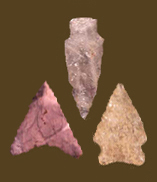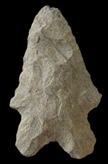
|
MACCORKLE
Chronology The MacCorkle point dates to the Early Archaic period, although some archaeologists, following Gardner (1989), see the introduction of bifurcate base points as the beginning of the Middle Archaic. Justice (1987) suggests a date range of 9000 to 8500 BP (approximately 8250-7575 BC in calendar years), while Broyles (1971) places it between 8850 and 8750 BP (8000-7750 BC), based on the stratigraphic position of examples recovered at the St. Albans site in West Virginia. However, Bergman et al. (1998) note that a few dates clustering around 9300-9400 B.P (the earliest being 9420 +/- 90, or approximately 8750 BC calendar) have been associated with bifurcate base points in Pennsylvania and New York. Description Blade: The blade is triangular, and has straight or slightly excurvate edges. Serrations may be shallow or deep. Point edges are thinned by many long, narrow flakes. The flat blade faces have large, random flake scars. Haft Element: The base is concave, and typically thinned with multiple small edge flakes on one face and a large single flake on the other face. Some basal grinding occurs from shoulder to shoulder on most examples. The stem is lobed and rounded, and finely chipped on the edges. Size: Length ranges from 40 to 63 mm. Width ranges from 22 to 35 mm. Thickness ranges from 3 to 6 mm. Stems range from 12 to 17 mm long and 18 to 26 mm wide. Technique of manufacture: Soft percussion flaking, followed by pressure retouching around the basal notch and serrated blade. Material: Cresthull (1972b) reported seven MacCorkle points from the Chance site on the Eastern Shore, with six made from chert/jasper and one chalcedony. In the area surrounding Zekiah Swamp on the lower Potomac, Wanser (1982) found just three MacCorkles, all rhyolite. In the Monocacy River drainage, 87% of 30 MacCorkle points were rhyolite and 13% quartzite (Kavanagh 1982). Chert is the predominate material for MacCorkles in the middle Potomac River Valley, but other local stones such as quartzite and rhyolite are also used (Hranicky 2002). In Delaware, bifurcate base points are commonly made from chert, jasper, and rhyolite (Custer 1996a). Discussion Defined in Literature References |
![]()
Search by Shape:
(See Projectile Point Typology) |

|
Thank you for visiting our website. If you have any
questions, comments, Copyright © 2002 by |

|

 Defining Attributes
Defining Attributes